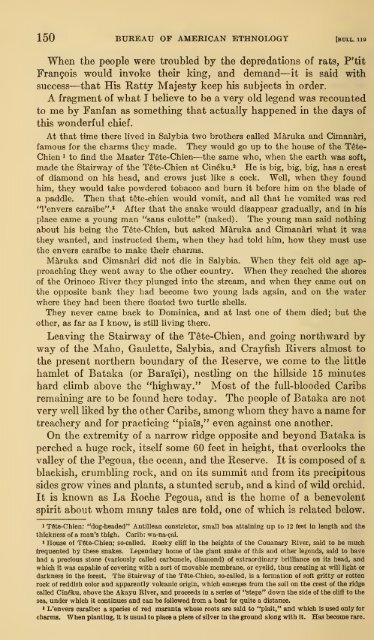Create successful ePaper yourself
Turn your PDF publications into a flip-book with our unique Google optimized e-Paper software.
150 BUKEAU OF AMERICAN ETHNOLOGY Iboti. no<br />
When the people were troubled by the depredations <strong>of</strong> rats, P'tit<br />
Frangois would invoke their king, and demand—it is said with<br />
success—that His Ratty Majesty keep his subjects in order,<br />
A fragment <strong>of</strong> what I believe to be a very old legend was recounted<br />
to me by Fanfan as something that actually happened in the days <strong>of</strong><br />
this wonderful chief.<br />
At that time there lived in Salybia two brothers called M&.ruka and Crman^ri,<br />
famous for the charms they made. <strong>The</strong>y would go up to the house <strong>of</strong> the Tdte-<br />
Chien ' to find the Master Tete-Chien—the same who, when the earth was s<strong>of</strong>t,<br />
made the Stairway <strong>of</strong> the Tete-Chien at Cin^ku.^ He is big, big, big, has a crest<br />
<strong>of</strong> diamond on his head, and crows just like a cock. Well, when they found<br />
him, they would take powdered tobacco and burn it before him on the blade <strong>of</strong><br />
a paddle. <strong>The</strong>n that t^te-chien would vomit, and all that he vomited was red<br />
"I'envers caraibe".' After that the snake would disappear gradually, and in his<br />
place came a young man "sans culotte" (naked). <strong>The</strong> young man said nothing<br />
about his being the T^te-Chien, but asked M^ruka and Ciman^ri what it was<br />
they wanted, and instructed them, when they had told him, how they must use<br />
the envers caraibe to make their charms.<br />
M^ruka and Cimana,ri did not die in Salybia. When they felt old age approaching<br />
they went away to the other country. When they reached the shores<br />
<strong>of</strong> the Orinoco River they plunged into the stream, and when they came out on<br />
the opposite bank they had become two young lads again, and on the water<br />
where they had been there floated two turtle shells.<br />
<strong>The</strong>y never came back to <strong>Dominica</strong>, and at last one <strong>of</strong> them died; but the<br />
other, as far as I know, is still living there.<br />
Leaving the Stairway <strong>of</strong> the Tete-Chien, and going northward by<br />
way <strong>of</strong> the Maho, Gaulette, Salybia, and Crayfish Rivers almost to<br />
the present northern boundary <strong>of</strong> the Reserve, we come to the little<br />
hamlet <strong>of</strong> Bataka (or Baraigi), nestling on the hillside 15 minutes<br />
hard climb above the "highway." Most <strong>of</strong> the full-blooded <strong>Caribs</strong><br />
remaining are to be found here today. <strong>The</strong> people <strong>of</strong> Bataka are not<br />
very well liked by the other <strong>Caribs</strong>, among whom they have a name for<br />
treachery and for practicing "piais," even against one another.<br />
On the extremity <strong>of</strong> a narrow ridge opposite and beyond Bataka is<br />
perched a huge rock, itself some 60 feet in height, that overlooks the<br />
valley <strong>of</strong> the Pegoua, the ocean, and the Reserve.<br />
It is composed <strong>of</strong> a<br />
blackish, crumbling rock, and on its summit and from its precipitous<br />
sides grow vines and plants, a stunted scrub, and a kind <strong>of</strong> wild orchid.<br />
It is known as La Roche Pegoua, and is the home <strong>of</strong> a benevolent<br />
spirit about whom many tales are told, one <strong>of</strong> which is related below.<br />
1 T6te-Chien: "dog-headed" Antillean constrictor, small boa attaining up to 12 feet in length and the<br />
thickness <strong>of</strong> a man's thigh.<br />
Carib: wa-na-cai.<br />
' House <strong>of</strong> Tete-Chien; so-called. Eocky clifl in the heights <strong>of</strong> the Couanary River, said to be much<br />
frequented by these snakes. Legendary home <strong>of</strong> the giant snake <strong>of</strong> this and other legends, said to have<br />
had a precious stone (variously called carbuncle, diamond) <strong>of</strong> extraordinary brilliance on its head, and<br />
which it was capable <strong>of</strong> covering with a sort <strong>of</strong> movable membrane, or eyelid, thus creating at will light or<br />
darkness in the forest. <strong>The</strong> Stairway <strong>of</strong> the T6te-Chien, so-called, is a formation <strong>of</strong> s<strong>of</strong>t gritty or rotten<br />
rock <strong>of</strong> reddish color and apparently volcanic origin, which emerges from the soil on the crest <strong>of</strong> the ridge<br />
called Oin6ku, above the Akayu River, and proceeds in a series <strong>of</strong> "steps" down the side <strong>of</strong> the clifl to the<br />
sea, under which it continues and can be followed from a boat for quite a distance.<br />
« L'envers caraibe: a species <strong>of</strong> red maranta whose roots are said to "plait," and which is used only for<br />
charms. When planting, It is usual to place a piece <strong>of</strong> silver in the ground along with It. Has become rare.

















